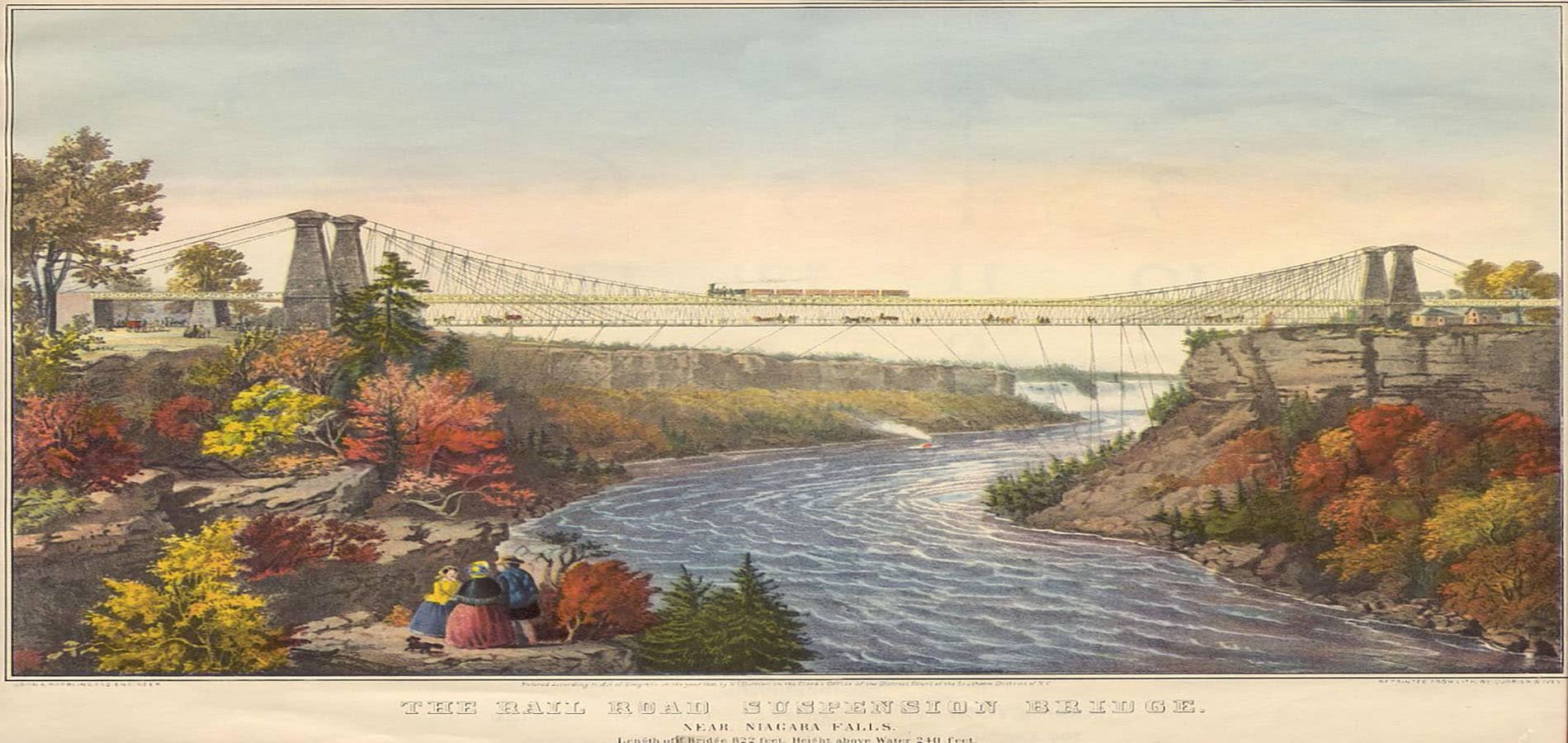The wildfires that ravaged the Hawai‘ian island of Maui and completely destroyed the city of Lahaina last month have rekindled conversations about the ethicality of tourism in Hawai‘i, a state where many of the world’s richest people have properties while many natives can no longer afford to live, as well as the controversial history of how Hawai‘i came to be an American state in the first place.
Join us as we dive into the story of how Hawai‘i went from an independent kingdom to being annexed into the United States, and the reclamation of native Hawai‘ian culture over the past few decades, with the help of several HeinOnline databases, including:
- Law Journal Library
- U.S. Statutes at Large
- State Constitutions Illustrated
- U.S. Congressional Serial Set
- And many more!
An Unlikely Beginning
The Hawai‘ian islands, alongside Easter Island and New Zealand, create the Polynesian Triangle, created of island groups that share similar cultures and climates. Although the date is argued amongst historians, it is generally agreed that Polynesians first settled in Hawai‘i around the seventh century—successfully navigating their way to the islands using canoes and expert analysis of the stars, winds, and currents (fun fact: this impressive feat inspired the 2016 Disney movie Moana). The native Hawai‘ians established a society based on a caste system, land tenure, and a polytheistic taboo (or kapu) religion that included strict rules and codes of conduct. Each island developed its own trade specialties, and four kingdoms were established: Hawai‘i, Maui, O‘ahu, and Kaua‘i.
Explorer James Cook[1]Henry E.; et al. Chambers. Baltimore, Slavery, and Constitutional History (1896). This document can be found in HeinOnline’s Legal Classics database. led the first English expedition that landed on the Hawai‘ian islands. However, it didn’t fare well for him—during one of his trips, a native was accused of stealing one of Cook’s longboats, and in the resulting skirmish, Cook was killed.
The Kamehameha Dynasty
The Kamehameha royal family came to rule Hawai‘i beginning with Kamehameha I who rose to power in 1795. He set about conquering all of the Hawai‘ian islands,[2]Ralph S.; Day Kuykendall, A. Grove. Hawaii: A History, from Polynesian Kingdom to American State (1961). This document can be found in HeinOnline’s World Constitutions Illustrated database. uniting them together under his rule. After his death, Kamehameha II took his place, leading with the help of his stepmother Ka‘ahumanu. Together, they brought about the end of Hawai‘i’s taboo religion[3]Kimo Alama Keaulana & Scott Whitney, Ka Wai Kau Mai O Maleka Water from America: The Intoxication of the Hawai’ian People, 17 CONTEMP. DRUG Probs. 161 (1990). This article can be found in HeinOnline’s … Continue reading by accepting the first Protestant missionaries to the island, who began to establish churches as well as encouraged the natives, who had only ever used oral language, to create an alphabet.[4]L. Kaipoleimanu Ka’awaloa, Translation v. Tradition: Fighting for Equal Standardized Testing ma ka Olelo Hawai’i, 36 U. HAW. L. REV. 487 (2014). This article can be found in HeinOnline’s Law Journal Library. During his rule, Kamehameha II traveled to other countries in order to gain recognition of Hawai‘i as an independent kingdom—however, he died from measles during a trip to London.
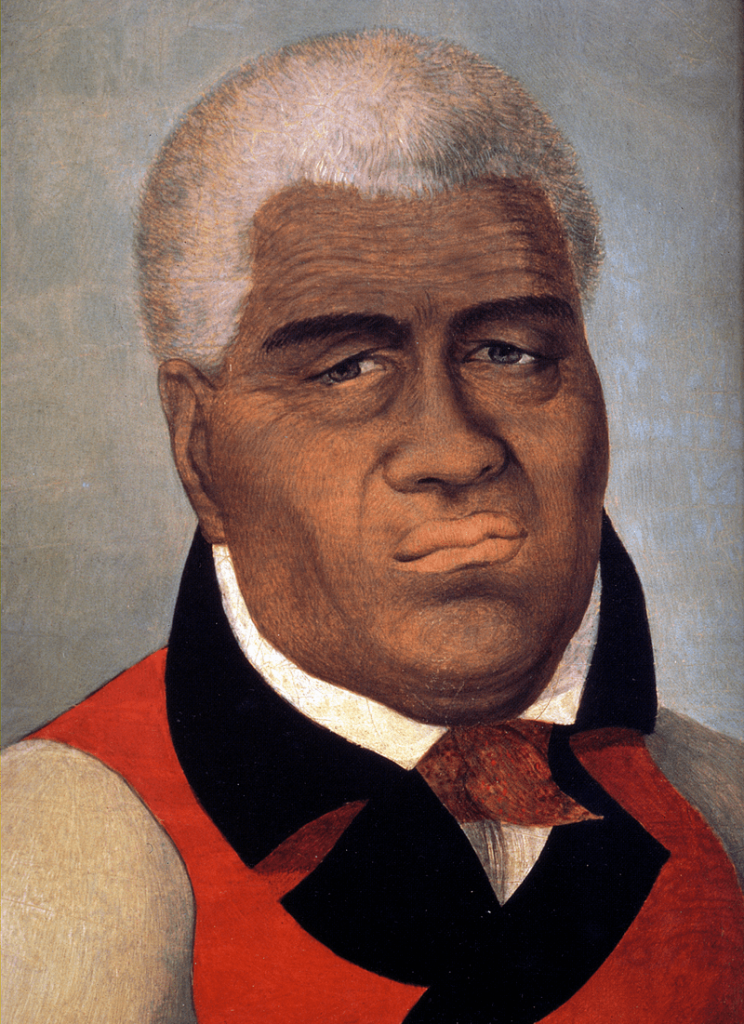
In response to colonization threats, Kamehameha III became the first ruler to create formal laws and government in the kingdom. He established Hawai‘i’s first constitution[5]Translation of the Constitution and Laws of the Hawaiian Islands, Established in the Reign of Kamehameha III (1842). This document can be found in HeinOnline’s Session Laws Library. in 1840, and continued his predecessor’s commitment to traveling and gaining international recognition, especially by Britain and France.
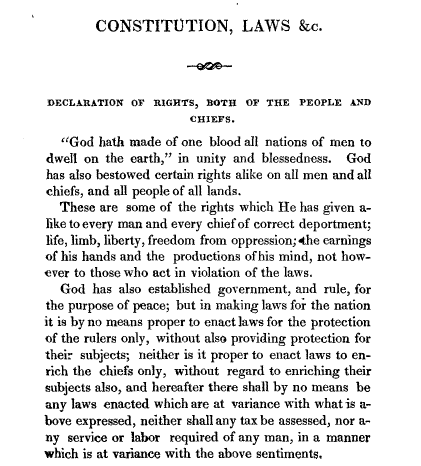
Meanwhile, due to Hawai‘i’s rich natural resources, non-natives began to travel to the islands to establish plantations—especially sugar plantations. The first sugar plantation[6]Christopher D. Hu, Transplanting Servitude: The Strange History of Hawai’i’s U.S.-Inspired Contract Labor Law, 49 Stan. J. INT’l L. 274 (2013). This article can be found in HeinOnline’s Law Journal Library. was built in Kaua‘i in 1835, and immigrants from various Asian nations were brought to work the fields, including Japan, China, the Philippines, and Korea. As the number of plantation owners in Hawai‘i increased, they began to demand influence in the kingdom’s politics and government, which Kamehameha IV and Kamehameha V would eventually need to navigate. However, many countries around the world continued to recognize Hawaiʻi as an independent nation.
Kalākaua and the Bayonet Constitution
After the death of Kamehameha V, King Kalākaua, also referred to as The Merry Monarch, was elected to the Hawai‘ian throne. However, his reign faced many challenges. He signed the Reciprocity Treaty of 1875,[7]William M. Malloy. Treaties, Conventions, International Acts, Protocols and Agreements 1776-1909 (Malloy) (1875). This document can be found in HeinOnline’s U.S. Treaties & Agreements Library. a free trade agreement with the United States set for seven years that would allow for sugar and other products to be exported to the United States duty-free, in exchange for economic privileges for the United States. The treaty was renewed in 1887, and included giving America exclusive use of Pearl Harbor, which the U.S. had been eyeing due to its strategic Pacific Ocean location. This treaty would result in continued influx of sugar plantations among the islands.
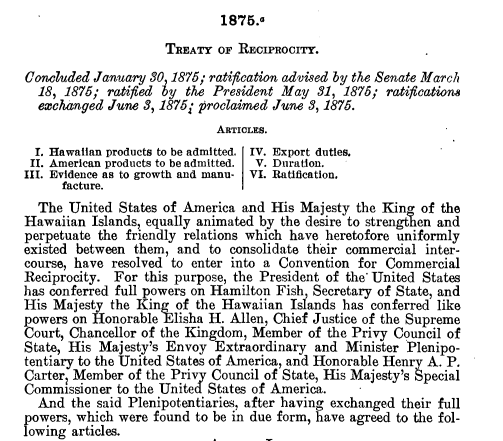
Additionally, in 1887, the Hawai‘ian League,[8]Lorrin A.; Farrell Thurston, Andrew, Editor. Memoirs of the Hawaiian Revolution (1936). This document can be found in HeinOnline’s Foreign Relations of the United States (FRUS) database. which consisted of non-natives with business interests in the kingdom, formed the Rebellion of 1887 and wrote their own constitution.[9]English original text of the Constitution of Kalakaua of 7 July 1887. 159 (1887) Constitution, Granted by Kalakaua, July 6, 1887. this document can be found in HeinOnline’s State Constitutions Illustrated database. They forced Kalākaua to dismiss his cabinet and sign this constitution, which drained his power and gave it to a new, non-native-controlled cabinet. Additionally, this constitution established property and income requirements[10]English original text of the Constitution of Kalakaua of 7 July 1887. 159 (1887) Constitution, Granted by Kalakaua, July 6, 1887. This document can be found in HeinOnline’s State Constitutions Illustrated database. in order to vote and run for government, effectively disenfranchising about two-thirds of native Hawai‘ians. However, the constitution did not require naturalization to vote, which essentially gave non-native Americans control over Hawai‘ian politics.
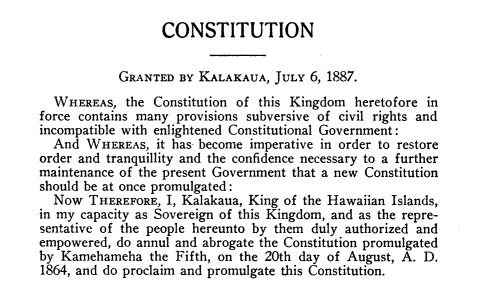
This constitution came to be called the Bayonet Constitution to indicate that it was signed by Kalākaua under force. In response to the rebellion, U.S. President Grover Cleveland and his Secretary of State, Thomas F. Bayard, wrote in instructions to American minister George W. Merrill that American interests and lives needed to be protected, and “the assistance of the officers of our Government vessels, if found necessary, will therefore be promptly afforded to promote the reign of law and respect for orderly government in Hawaii.”[11]“Presidential message transmitting correspondence on Hawaii.” U.S. Congressional Serial Set, , 1893, pp. 1-64. HeinOnline, https://heinonline.org/HOL/P?h=hein.usccsset/usconset33022&i=143. This document can be found in … Continue reading
The Overthrow of Lil’uokalani
In time, Kalākaua’s distant cousin Robert William Wilcox and members of the Committee of Safety plotted to overthrow Kalākaua and replace him with his sister, Princess Lil’uokalani. However, the plot, called the Wilcox Rebellion,[12]Hugh Chisholm, Editor. Encyclopedia Britannica: A Dictionary of Arts, Sciences, Literature and General Information (11). This document can be found in HeinOnline’s Legal Classics database. was thwarted, and Wilcox was sent into exile. Lil‘uokalani then took the throne after Kalākaua’s death. Queen Lil‘uokalani sought to revise the Hawai‘ian constitution to re-extend the vote and other rights for native Hawai‘ians. She proposed a new constitution, which would reduce property requirements while disenfranchising many of Hawai‘i’s non-citizens. However, her cabinet did not support the constitution, and the resulting fury of American and European businessmen in Hawai‘i led to her overthrow, which began on January 17, 1893.[13]“Foreign Relations, 1894, Appendix 2: Affairs in Hawaii.” Congressional Serial Set, , 1894, pp. 1-1438. HeinOnline, https://heinonline.org/HOL/P?h=hein.usccsset/usconset51454&i=232. This document can be found in … Continue reading Around 1,500 armed and non-native men formed the Honolulu Rifles, which, supported by the U.S. Government Minister John L. Stevens,[14]Native Hawaiian Government Reorganization Act of 2005 (2006). This document can be found in HeinOnline’s Civil Rights and Social Justice database. proceeded to storm the palace. The queen was put under house arrest,[15]Fred L. Borch, The Trial by Military Commission of Queen Liliuokalani, 2014 ARMY LAW. 1 (2014). This document can be found in HeinOnline’s Law Journal Library. and the Kingdom of Hawai‘i was declared the Republic of Hawai‘i. In response, Stevens sent U.S. marines and sailors to the islands, and though they did not participate in the rebellion, their presence alone scared those who sought to protect Queen Lil‘uokalani.
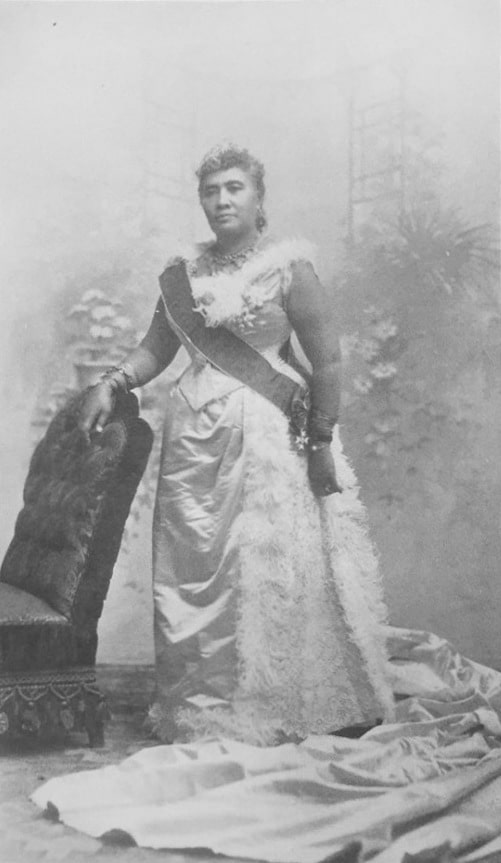
Sanford Ballard Dole, the leader of the coup and founder of the Hawai‘ian Pineapple Company (now the Dole Food Company) was named the president of the Republic of Hawai’i,[16]English text of the Constitution of the Republic of Hawaii, adopted by the Constitutional Convention on 3 July 1894 and which entered into force the following day. 9 (2021) The President. This document can be found in HeinOnline’s State … Continue reading and the Committee of Safety was instilled as the republic’s interim government.
Annexation and Statehood
With the onset of the Spanish-American war, the United States government wanted control of the strategically located Pearl Harbor. Despite Japan sending warships to Hawai‘i to oppose American annexation of the republic, newly sworn in President William McKinley proposed a treaty annexing Hawai‘i, although it didn’t gain the necessary votes. However, a joint resolution written by Democratic Congressman Francis G. Newlands to annex Hawai‘i[17]To provide for annexing the Hawaiian Islands to the United States., . 30 Stat. 750 (1898). This act can be found in HeinOnline’s U.S. Statutes at Large database. passed with a simple majority in Congress, and McKinley signed it into law on July 7, 1898. This effectively created the Territory of Hawai‘i, and the Hawaiian Organic Act[18]To provide a government for the Territory of Hawaii., Chapter 339, 56 Congress, Public Law 56-339. 31 Stat. 141 (1900). This act can be found in HeinOnline’s U.S. Statutes at Large database. established a territorial government. A few years later, the constitutionality of the annexation was recognized in the U.S. Supreme Court case De Lima v. Bidwell (1901).[19]De Lima v. Bidwell, 182 U.S. 1, 220 (1901). This case can be found in HeinOnline’s U.S. Supreme Court Library.

Japan infamously attacked Pearl Harbor during World War II, killing more than 2,400 people, including nearly 70 civilians. Subsequently, Hawai‘i was placed under martial law for more than three years, and many of those of Japanese descent on the island were forced into internment camps in mainland America.
On March 18, 1959, President Eisenhower signed the Hawaii Statehood Admission Act[20]To provide for the admission of the State of Hawaii into the Union., Public Law 86-3, 86 Congress. 73 Stat. 4 (1959). This act can be found in HeinOnline’s U.S. Statutes at Large database. into law, which established Hawai‘i as the 50th state on August 21, 1959.
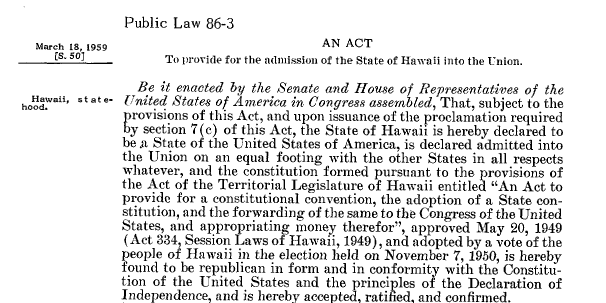
Hawai‘i Today
After the annexation of Hawai‘i, many native Hawai‘ians were deprived of their Indigenous culture. For example, the Hawai‘ian language wasn’t allowed to be taught or used in schools. However, during what is referred to as the Hawai‘ian Renaissance[21]Tehani M. Louis-Perkins, Mai Keia Manawa a Mau Loa Aku: Kanaka Maoli Governance through Nearshore Fisheries Management in Mo’omomi, 45 U. HAW. L. REV. 185 (2022). This article can be found in HeinOnline’s Law … Continue reading of the 1970s, native Hawai‘ians began to reclaim their culture, learning traditional skills such as navigation, voyaging, and surfing, and reinstating the Hawai‘ian language into schools. In fact, Hawai‘ian was made an official state language.
President Bill Clinton signed the “Apology Resolution”[22]To acknowledge the 100th anniversary of the January 17, 1893 overthrow of the Kingdom of Hawaii, and to offer an apology to Native Hawaiians on behalf of the United States for the overthrow of the Kingdom of Hawaii., Public Law 103-150, 103 … Continue reading which belatedly apologized “to Native Hawaiians on behalf of the people of the United States for the overthrow of the Kingdom of Hawaii on January 17, 1893… and the deprivation of the rights of Native Hawaiians to self-determination.”

Today, tourism and the American military are the two largest sectors of the Hawai‘ian economy. The price of real estate is, on average, the highest of any state in the U.S., which is why many wealthy Americans, including Jeff Bezos, Mark Zuckerberg, and Oprah Winfrey, own properties on the islands. Oracle Corp. CEO Larry Ellison, one of the richest people in the world, owns almost the entire island of Lanai. Many native Hawai‘ians are no longer able to afford to live on the islands, and this is a conversation that has been brought to national attention recently with the destruction of the tourist city Lahaina due to wildfires.
Continue Your Research with HeinOnline’s State Content
Did you know that HeinOnline doesn’t just contain federal content, but also includes a wide variety of state-level content as well? From National Survey of State Laws, State Constitutions Illustrated, and our Session Laws Library, to historical archives of State Statutes and Reports, State Attorney General Reports and Opinions, and Prestatehood Legal Materials, you can use HeinOnline databases to explore the history of not just Hawai‘i, but all 50 American states.
HeinOnline Sources[+]
| ↑1 | Henry E.; et al. Chambers. Baltimore, Slavery, and Constitutional History (1896). This document can be found in HeinOnline’s Legal Classics database. |
|---|---|
| ↑2 | Ralph S.; Day Kuykendall, A. Grove. Hawaii: A History, from Polynesian Kingdom to American State (1961). This document can be found in HeinOnline’s World Constitutions Illustrated database. |
| ↑3 | Kimo Alama Keaulana & Scott Whitney, Ka Wai Kau Mai O Maleka Water from America: The Intoxication of the Hawai’ian People, 17 CONTEMP. DRUG Probs. 161 (1990). This article can be found in HeinOnline’s Law Journal Library. |
| ↑4 | L. Kaipoleimanu Ka’awaloa, Translation v. Tradition: Fighting for Equal Standardized Testing ma ka Olelo Hawai’i, 36 U. HAW. L. REV. 487 (2014). This article can be found in HeinOnline’s Law Journal Library. |
| ↑5 | Translation of the Constitution and Laws of the Hawaiian Islands, Established in the Reign of Kamehameha III (1842). This document can be found in HeinOnline’s Session Laws Library. |
| ↑6 | Christopher D. Hu, Transplanting Servitude: The Strange History of Hawai’i’s U.S.-Inspired Contract Labor Law, 49 Stan. J. INT’l L. 274 (2013). This article can be found in HeinOnline’s Law Journal Library. |
| ↑7 | William M. Malloy. Treaties, Conventions, International Acts, Protocols and Agreements 1776-1909 (Malloy) (1875). This document can be found in HeinOnline’s U.S. Treaties & Agreements Library. |
| ↑8 | Lorrin A.; Farrell Thurston, Andrew, Editor. Memoirs of the Hawaiian Revolution (1936). This document can be found in HeinOnline’s Foreign Relations of the United States (FRUS) database. |
| ↑9 | English original text of the Constitution of Kalakaua of 7 July 1887. 159 (1887) Constitution, Granted by Kalakaua, July 6, 1887. this document can be found in HeinOnline’s State Constitutions Illustrated database. |
| ↑10 | English original text of the Constitution of Kalakaua of 7 July 1887. 159 (1887) Constitution, Granted by Kalakaua, July 6, 1887. This document can be found in HeinOnline’s State Constitutions Illustrated database. |
| ↑11 | “Presidential message transmitting correspondence on Hawaii.” U.S. Congressional Serial Set, , 1893, pp. 1-64. HeinOnline, https://heinonline.org/HOL/P?h=hein.usccsset/usconset33022&i=143. This document can be found in HeinOnline’s U.S. Congressional Serial Set. |
| ↑12 | Hugh Chisholm, Editor. Encyclopedia Britannica: A Dictionary of Arts, Sciences, Literature and General Information (11). This document can be found in HeinOnline’s Legal Classics database. |
| ↑13 | “Foreign Relations, 1894, Appendix 2: Affairs in Hawaii.” Congressional Serial Set, , 1894, pp. 1-1438. HeinOnline, https://heinonline.org/HOL/P?h=hein.usccsset/usconset51454&i=232. This document can be found in HeinOnline’s U.S. Congressional Serial Set. |
| ↑14 | Native Hawaiian Government Reorganization Act of 2005 (2006). This document can be found in HeinOnline’s Civil Rights and Social Justice database. |
| ↑15 | Fred L. Borch, The Trial by Military Commission of Queen Liliuokalani, 2014 ARMY LAW. 1 (2014). This document can be found in HeinOnline’s Law Journal Library. |
| ↑16 | English text of the Constitution of the Republic of Hawaii, adopted by the Constitutional Convention on 3 July 1894 and which entered into force the following day. 9 (2021) The President. This document can be found in HeinOnline’s State Constitutions Illustrated database. |
| ↑17 | To provide for annexing the Hawaiian Islands to the United States., . 30 Stat. 750 (1898). This act can be found in HeinOnline’s U.S. Statutes at Large database. |
| ↑18 | To provide a government for the Territory of Hawaii., Chapter 339, 56 Congress, Public Law 56-339. 31 Stat. 141 (1900). This act can be found in HeinOnline’s U.S. Statutes at Large database. |
| ↑19 | De Lima v. Bidwell, 182 U.S. 1, 220 (1901). This case can be found in HeinOnline’s U.S. Supreme Court Library. |
| ↑20 | To provide for the admission of the State of Hawaii into the Union., Public Law 86-3, 86 Congress. 73 Stat. 4 (1959). This act can be found in HeinOnline’s U.S. Statutes at Large database. |
| ↑21 | Tehani M. Louis-Perkins, Mai Keia Manawa a Mau Loa Aku: Kanaka Maoli Governance through Nearshore Fisheries Management in Mo’omomi, 45 U. HAW. L. REV. 185 (2022). This article can be found in HeinOnline’s Law Journal Library. |
| ↑22 | To acknowledge the 100th anniversary of the January 17, 1893 overthrow of the Kingdom of Hawaii, and to offer an apology to Native Hawaiians on behalf of the United States for the overthrow of the Kingdom of Hawaii., Public Law 103-150, 103 Congress. 107 Stat. 1510 (1993). This act can be found in HeinOnline’s U.S. Statutes at Large database. |



